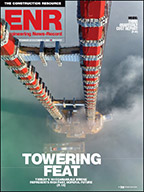Bridge Projects Abound Throughout African Continent
Mariana says the bridge also will have “fully corrugated concrete” on its walls for decoration. “The boundary between the corrugated concrete and smooth concrete is marked by a curved line that draws a ripple scale.”
Meanwhile, in East Africa, Uganda and Tanzania are at different stages of bridge construction to help unclog the northern and central corridors, respectively. The northern corridor links the Indian Ocean port city of Mombasa in Kenya to neighboring Uganda, Rwanda, Burundi and the Democratic Republic of the Congo. Japan’s Zenitaka Corp. holds a construction contract, awarded by the Uganda Roads Authority (URA), for the $125-million New Jinja Bridge, nicknamed the "second Nile bridge."
The new, 525-m-long cable-stayed bridge has two 80-m-high, reinforced-concrete inverted-Y pylon towers, with substructures comprising 2-m-dia piles driven 20 m deep and socketed into sound rock with reinforced-concrete caps, according to a URA project brief. The superstructure will have a cellular concrete deck, supported by a central plane of multi-strand stay cables cascading from the inverted, Y-shaped concrete pylons.
Meanwhile, in Tanzania, completion of the country’s first cable-stayed bridge project has been delayed for six months to enable a Chinese consortium to address unforeseen challenges.
Begun in 2012, the 680-m-long cable-stayed bridge in the Temeke district now is expected to be completed in July 2015. Works Ministry Permanent Secretary Mussa Iyombe stated that China Railway Jiangchang Engineering Ltd. and China Major Bridge Engineering Co. encountered technical challenges in implementing the $136-million contract.
Iyombe noted that, during the installation of pillars to support the 27.5-m-wide bridge, it took an additional five months for the contractor to reach the required sand, at a depth of 84 m. The depth was anticipated to be 64 m.
“Due to the challenges the construction firm has faced, which I regard as genuine, the government has thought it wise to grant a six-month extension. This is a big project which thousands of people depend on, but it cannot materialize unless the pillars to support the bridge are installed,” Iyombe told Tanzania media.
The bridge and 2.5 km of approach roads were designed by Arab Consulting Engineers; 60% of fiunding is by the National Social Security Fund and 40% is by the government of Tanzania. Replacing the current Kivukoni ferry, the bridge will link the central business district of the capital, Dar es Salaam, to Kigamboni ward. The span will be operated as a toll bridge for 25 years.
In West Africa, Gambia and Senegal are putting the final touches on plans for the construction of the Trans-Gambia Bridge on the Gambia River. The crossing will ease traffic flow between the northern and southern parts of Gambia and Senegal. The 942-m-long cantilevered bridge with prestressed-concrete segments is expected to reduce travel time, boost trade and improve freight movement on the so-called Gambia Road Transport Corridor, an economic and strategic link connecting Gambia and Senegal to West Africa.

